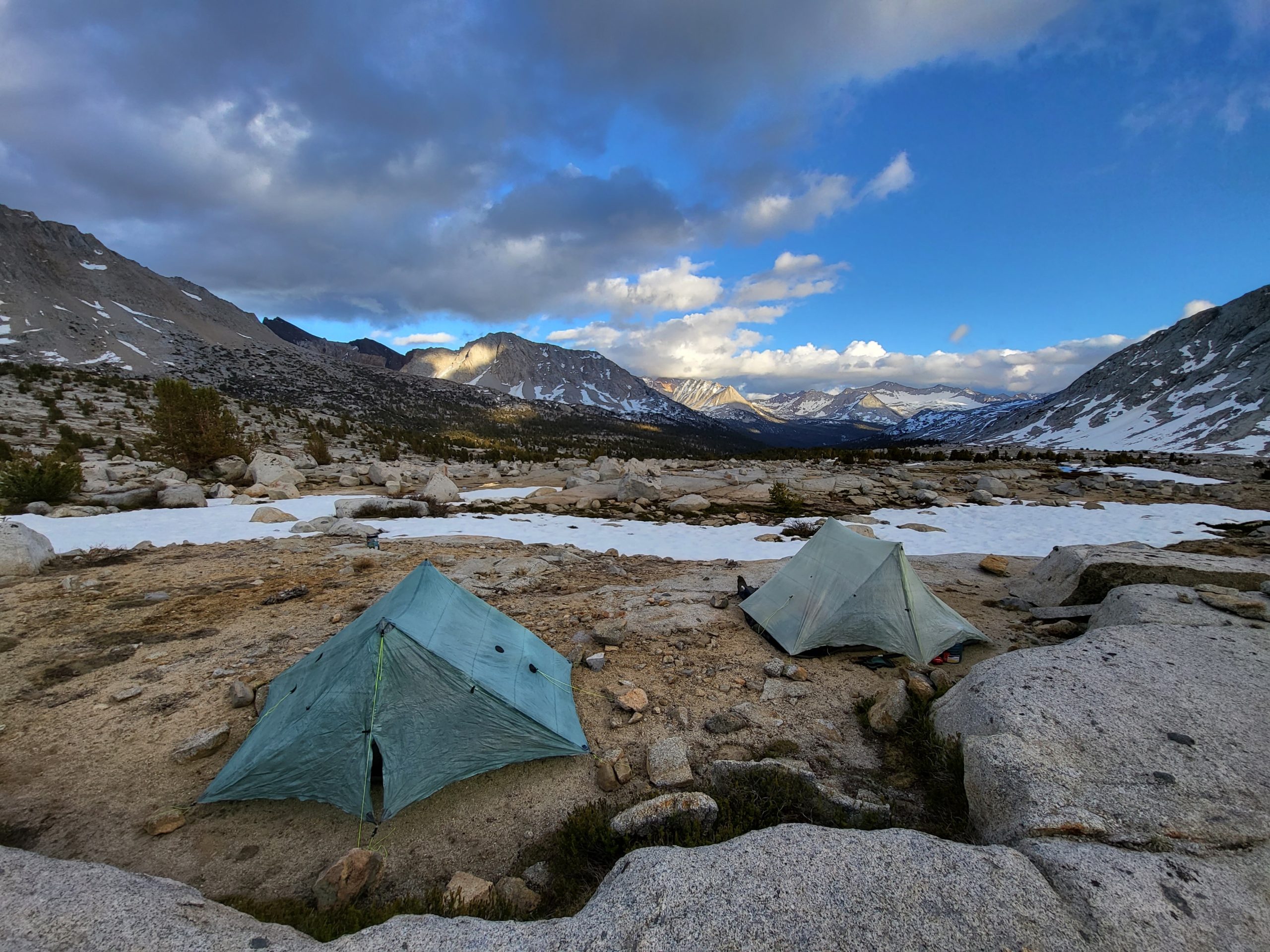How To Seam Seal Your Tent: Step-by-Step Guide
Your tent is arguably one of the most important pieces of backpacking gear you own. After all, it’s going to be your home away from home for the next however-many miles. And somewhere along the way, it’s likely that you’re going to depend on it to keep you warm and dry. Seam sealing your tent is a surefire way to ensure it will weather the next storm—or several—on your trip.
Seam Sealing 101
Your tent isn’t just one continuous piece of fabric, although that would be cool. The fabric of your tent is stitched together in multiple places, and these seams are potential weak spots that can leak. Fortunately, though, once they’re fortified with a sealant or tape, they do an excellent job at keeping water out.
Tents are seam sealed by using either tape or sealant. Tent manufacturers sometimes waterproof seams by taping them at the factory. Unlike tape, sealant is a glue-like waterproof chemical you can apply yourself.
READ NEXT – Best Tents for Thru-Hiking

This urethane-based seam sealer from Gear Aid is a solid choice.
Here’s the thing: most tents from larger companies—REI, Big Agnes, etc.—come already seam sealed, but that’s not often the standard with cottage companies. Many cottage brands do offer the option to do it for you at an additional cost of $30 or so. In general, Dyneema Composite Fabric (DCF) tents don’t need to be seam sealed at home, but you still can for a little extra protection.
When purchasing a tent, read the specs to determine if it already comes with sealed or taped seams. If it does, awesome! You’re good for the time being. If it doesn’t, you can either fork out a few extra bucks to have it done for you—or, better yet—you can do it yourself.

Don’t let this be you! Know your stuff and routinely check your tent seams for wear. Photo via Eloise Robbins.
FYI: Even if your tent came with sealed seams, it’s good practice to get in the habit of routinely inspecting them for wear (i.e. peeling tape). After a few seasons of hard use, it’s almost guaranteed that the seams will need to be resealed. An added benefit of seam sealing is that it will also reinforce the seams so they’ll be less likely to fray or split.
How To Seam Seal Your Tent
Let’s get to it. These step-by-step instructions will allow you to perform your own seam sealing service on the cheap. It’ll only take an hour or so of your time, and it’s fairly easy and inexpensive.
Step 1: Set up the tent outside on a dry, warm day.
Check the weather forecast to make sure that the next 24 hours will be dry and warm, too. This is necessary for the sealant to dry properly.
Start by setting up your tent. Next, examine all of the seams. If you notice any seam tape coming loose on the underside of the fly, carefully peel it off. Leave intact tape in place.
A word on tape: A properly taped tent will have a layer of clear tape integrated into all the seams, both along the walls and the floor of the tent.
Step 2: Make sure you have the proper seam sealer for your tent and rainfly.
Most rainflys are polyester or nylon and have a silicone or polyurethane coating. Dyneema has become an increasingly used common material as well.
It’s important to note that each type of material requires a specific seam sealer formulated specifically for that fabric. Thankfully, it’s pretty easy to match each fabric to its correct seam-sealing counterpart.
Tents/rainflys with a polyurethane coating have to be treated with a urethane-based sealer.
Silicone-treated fabrics need a silicone-based sealer. Dyneema (if you choose to give it extra fortification) would also fall under this category.
Step 3: Prep the seams.
Before you begin the application process, first use a rag and rubbing alcohol to gently clean the seams. This will help prep them for the new sealant. Give the fabric a few minutes to dry.
Additionally, it’s prudent to use painter’s tape to cover up zippers and any areas bordering mesh. This will help ensure that you don’t accidentally apply sealer to these sensitive areas.
READ NEXT – Why You Need To Learn Gear First Aid Before Your Next Thru-Hike
Step 4: Apply seam sealer!
Using the included brush, spread the sealer into a smooth, even coating along the inside of each seam. You’re going to want to seal all seams on the inner side of the tent body and the underside of the rainfly, if your tent comes with a separate fly. If your shelter has a bathtub floor, you should seal those seams as well.
Even if it looks like only one or two seams need repairing, the other seams are likely on their way out as well. Save yourself the time and trouble and do all of them at once.
Pro tip: You can also fix tiny holes in the main tent fabric with seam sealer.
Step 5: Give the seam sealer ample time to dry.
Most products need 24 hours to dry. Check your product’s instructions to be sure.
Step 6. (Optional) Spray your tent/rainfly with water.
After the sealant has fully dried, feel free to test out your handiwork. Using a garden hose, give your tent/rainfly a good hose down and examine it for any leaks. Better now than on-trail in the middle of a torrential downpour, right?
DIY Seam Sealer
Want to make your very own seam sealer? If so, it’s totally doable and might save you some cash, especially if you have multiple pieces of gear that are in need of repair. In case it didn’t already cross your mind, you can seam seal other pieces of foul-weather gear such as rain jackets, pants, and mitts, to name a few. A tiny one-ounce tube of sealer may not last you.
Recipe for DIY silicone sealer:
Get yourself a tube of clear 100 percent silicone caulk and a bottle of mineral spirits from Walmart or any home improvement store. Mix together thoroughly in a separate container at a 50/50 ratio.
You want the mixture to have the consistency of olive oil—thick enough to stick to the brush, but not runny. If it’s too runny, add more caulk. If the opposite is true, just add more spirits. Same as you would with a pre-made commercial product, apply a thin, even layer across the length of the seam and allow 24 hours to dry. It’s as simple as that.
Maintenance
How long will your sealing service last? It should be good for the season, but it’s a good idea to get in the habit of routinely checking seams for wear. Next time you return from a trip, do yourself a favor and give all of the seams a quick glance over.
On another note, if you’ve recently seam-sealed your tent and are having issues with water leaking, it may be time to renew the waterproof coating on the fabric. The durable water repellent (DWR) coating on the outside of your rainfly can wear down over time. If you need to renew the DWR coating on your tent/rainfly (or other gear), this Nikwax product at REI will do the trick.
Let the Rain Fall Down
Let the rain or whatever inclement weather Mother Nature has in store come down. Let it try to ruin your fun on trail because, chances are, it won’t succeed. Thanks to your love for the outdoors—not to mention your newfound knowledge on how to keep your shelter watertight— you can rest easy knowing that a fantastic adventure awaits you.
If you were already aware of this information and consider yourself a seam sealing pro, feel free to share any advice you may have in the comments below.
Happy hiking, and be sure to subscribe to The Trek’s newsletter so you never miss an update.
READ NEXT – Do You Really Need Rain Pants for Backpacking?
Featured image: MSR Hubba Hubba 2. Anne K. Baker photo.
This website contains affiliate links, which means The Trek may receive a percentage of any product or service you purchase using the links in the articles or advertisements. The buyer pays the same price as they would otherwise, and your purchase helps to support The Trek's ongoing goal to serve you quality backpacking advice and information. Thanks for your support!
To learn more, please visit the About This Site page.

 ">
">





Comments 3
I don’t understand how the cottage gear companies get away with selling tents that are unfit for purpose. They charge premium prices for what is guaranteed to be a leaking tent unless the customer finishes the manufacturing process by sealing the seams to make it waterproof. To make it worse, if the manufacturer does it (for an additional fee), its not done with seam sealing tape, but with a silicone that is painted on – and makes your new tent look like a toddler finger painted it on. Having to reseal seams after a few seasons is normal maintenance for any tent, but on day 1 for a tent that I just paid a premium for – hard, hard pass.
Nice article. Always remember after you use Seam Grip that after it dries coat all the sealed areas with a Talcum or Baby Powder. Corn starch works too. This will remove any tackiness from the sealer. If you do not do this Seam Grip will attach itself to the urethane waterproofing and could ruin it when you pull it apart.
do you indicate that the seam seal is on the inside of the tent? You stated the inside of the seam.
Just a question.